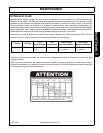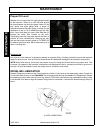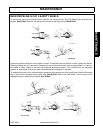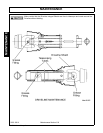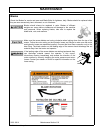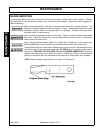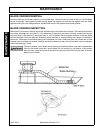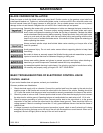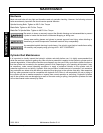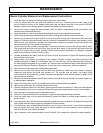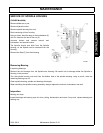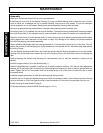
MAINTENANCE
2160 06/11 Maintenance Section 5-13
©2011 Alamo Group Inc.
MAINTENANCE
BLADE CARRIER INSTALLATION
Clean the taper on both the blade carrier and output shaft. Position carrier on the gearbox output shaft and
install special washer nut. Tighten nut, while holding blade carrier, to minimum 450 ft./lbs. strike the carrier near
the hub several times with a heavy hammer to seat the hub. Use a suitable spacer over the nut to prevent
damage to the nut and threads. Retighten the nut to 450 ft./lbs. Install cotter pin and spread.
Operating the mower with a loose blade pan or holder can damage the taper connection on
the gearbox output shaft. To ensure proper seating between the blade holder and output
shaft, check and tighten the retaining nut after the first day of operation. Recheck the blade
carrier attachment each morning before operating. Grasp the carrier firmly with both hands
and try to push and pull the carrier with one hand while pulling and pushing with the other
hand to try to rock or oscillate the blade carrier. If the carrier is loose, tighten the retaining nut
before operating the mower.
Always recheck spindle output shaft slotted blade carrier retaining nut torque after a few
hours of operation.
Avoid personal injury. Do not work under mower without supporting blocks to keep frame
from falling.
Be certain to clamp or securely support the Spindle Housing and sub-assemblies to prevent
injuries to hands and feet due to inadvertent dropping or falling over.
Always wear safety glasses and gloves to prevent eye and hand injury when chiseling or
hammering on metal components. Hardened material will chip unexpectedly.
An assembled spindle housing is quite heavy. Use a hoist or get help to handle them safely.
Lift carefully and properly using you legs to lift - NOT YOUR BACK.
BASIC TROUBLESHOOTING OF ELECTRONIC CONTROL VALVE
CONTROL HANDLE
If your control handle does not operate, recheck your installation.
Common problems are listed below.
1. Check electrical supply with a voltmeter. Connect the positive lead from the meter to the red wire that
supplies power to the handle and connect the other lead to the frame of the vehicle. Reading should be
12-14 volts. Be certain that the ground wire from handle is securely connected to the frame of the vehicle.
2. Check for power at valve or load. Connect positive lead to each of the wires that supply the load, connect
the other lead to vehicle ground. Operating buttons on handle should turn each wire on/off, 12-14 volts.
3. Check for proper grounding of valve or load. Connect positive lead to the valve block or to the ground
connection of the load, connect the other lead to the vehicle frame (ground). There should be little or no
voltage present. If there is a reading of more than 1/2 volt, ground between valve or load and the frame of
vehicle is bad.
4. If voltage is present at coil terminal and ground connection is good, check to see if solenoid coil is being
energized by touching the large nut on the top of the coil with a screwdriver or small wrench. When coil is
energized, the tool will lightly stick to the top of the coil until turned off.



